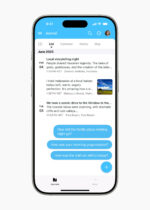A friend of mine, Michael Willems, posted onto his blog, “…the more I see OS X Lion, Apple’s new OS, the less I like it. No—the more I hate it. It is a dumb downgrade, designed to make your powerful computer into a dumb iPad.”
Meanwhile, it’s clear that the user interface design of Microsoft’s Windows 8 operating system for desktops, notebooks and tablets—called Metro—is designed to mimic the user experience of the company’s smartphone operating system, Windows Phone 7.5.
This is a reversal of what we experienced with earlier versions of Windows-based phones. Remember the silliness of having a desktop-style user interface on a pocket device? Who wants to push the “Start” button on a phone?
Yet when it comes to innovation, it all seems to be starting on the phone or tablet, and continues right to the cloud—bypassing the desktop and also the traditional enterprise server.
Consider, for example:
• September 27: The rollout of Windows Phone 7.5 begins, and includes a Web Marketplace store. While most consumers won’t get their “Mango” for a little while yet, this shows that Microsoft is back in the game. I expect Mango-based phones to appeal to both consumers and developers. (There’s no Mango Tablet in sight; Microsoft’s tablets will run the Windows 8 desktop operating system, not the Windows Phone platform.)
• September 28: Amazon.com formally announces the Kindle Fire, a 7-inch Android tablet designed to both take on Apple’s iPad and drive business to Amazon’s store. The back end of the Kindle Fire’s new Silk browser and user experience is processing and storage in Amazon S3 and Amazon Web Services.
• October 4: This is the date that Apple is expected to release its iOS 5 operating system and iPhone 5 handset. The biggest innovation in iOS 5 is iCloud, a massively revamped version of Apple’s rather pathetic MobileMe online service. iCloud provisions the iPad and iPhone directly, bypassing the iTunes desktop client.
Now, one might argue that all this consumer-electronics stuff doesn’t matter. This is all about Amazon selling more books and movies, Google selling more ads, Apple selling more hardware, Microsoft selling more something-or-another. What does that have to do with enterprise software development, beyond making sure that, if you’ve got some apps for your customers, partners and employees, they run correctly on those devices?
From an IT perspective, this matters a lot, because we’re losing control over our endpoints. Ahh, for the good old days when mainframes ruled, and we issued our employees dumb terminals! Heck, I miss the days when IT set standards for desktops and notebooks.
After our employees are seduced by Big Vendors’ marketing messages (and by brand loyalty, their favorite carriers, and a broad selection of game apps), it’s our job to make it all work, which is increasingly challenging in a world filled with walled gardens.
Beyond HTML5, there’s little commonality in any of the mobile platforms. That’s our problem, of course, not the consumer’s.
See this article from The New York Times: “More Offices Let Workers Choose Their Own Devices.” Does this describe your organization? What effect does this have on you? Write me at feedback@bzmedia.com.
Alan Zeichick is editorial director of SD Times. Read his blog at ztrek.blogspot.com.






